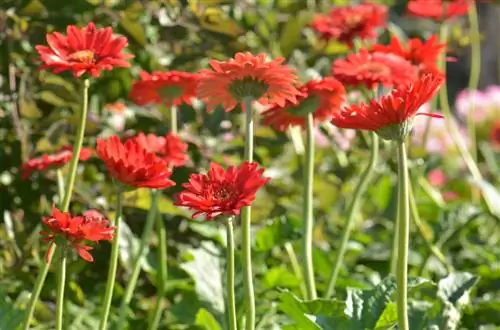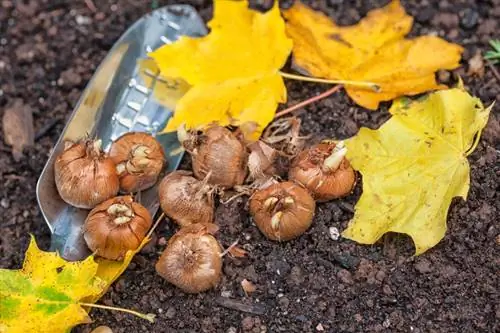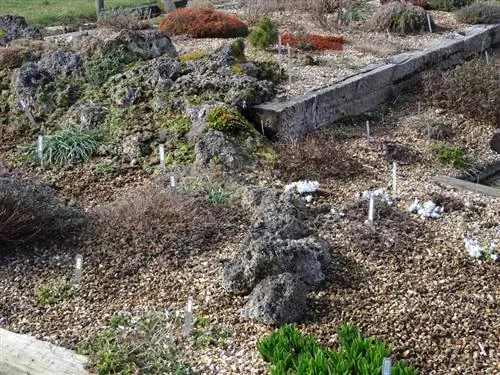- Author admin [email protected].
- Public 2023-12-16 16:46.
- Last modified 2025-06-01 06:02.
Read a commented sedge profile with explanations of Carex species here. You can find out how to properly plant and care for a sedge here.

What are sedges and what special features do they have?
Sedges (Carex) are ornamental grasses from the sourgrass family that are native to East Asia and North America. With over 2,000 species, they are very diverse and are suitable as solitary plants, ground cover or container plants. Special features are its triangular leaves and the inconspicuous flowers in the shape of spikes, panicles or grapes.
Profile
- Scientific name: Carex
- Family: Sourgrass family (Cyperaceae)
- Genus: Sedges with 2200 species
- Origin: East Asia, North America
- Growth type: ornamental grass
- Growth: persistent, herbaceous
- Leaves: triangular, narrow-flat leaf blade
- Leaf characteristics: sharp-edged leaf edge
- Flowers: spikes, panicles, grapes
- Roots: rhizomes, with or without runners
- Winter hardiness: hardy
- Use: Solitaire, ground cover, potted plant
Species
Sedges are a species-rich genus of evergreen and wintergreen ornamental grasses. Sedge grasses are native to cold to temperate climate regions, such as East Asia and North America. Thanks to this origin, the sour grass family inspires as perennial and multi-faceted design components for every garden situation. Whether as a solitary plant in the front garden, as a picturesque gap filler in the perennial bed or as a ground cover for a sea of waving stalks; With more than 2,000 species, there is the right sedge for every hobby gardener. The following table introduces you to 10 beautiful Carex species:
| Name | Botanical name | Growth height | Leaf Color | Growth | Speciality |
|---|---|---|---|---|---|
| Panicle sedge | Carex paniculata | 60-100 cm | greygreen | wintergreen | light brown flower panicles |
| Hanging sedge, giant sedge | Carex pendula | 40-120 cm | dark green | wintergreen | strong growth, very hardy |
| Broadleaf sedge | Carex plantaginea | 20-30 cm | shiny-light green | evergreen | arching shade perennial |
| Japan sedge | Carex morrowii | 30-40 cm | dark green | wintergreen | can tolerate root pressure |
| Blue-green sedge | Carex flacca | 20-80 cm | blue-green | wintergreen, creeping | decorative ground cover |
| Morning Star Sedge | Carex grayi | 20-70 cm | green | wintergreen, upright-arched | thrives on the swampy pond bank |
| New Zealand sedge | Carex buchananii | 25-40 cm | fox red stalks | evergreen | does not require cutting |
| Forest sedge | Carex sylvatica | 30-70 cm | light green | wintergreen | shade tolerant |
| Japan Gold Sedge | Carex oshimensis | 20-30 cm | dark green, yellow central stripes | wintergreen | hemispherical, beautiful in a bucket |
| Slender sedge | Carex acuta | 60-120 cm | in fresh green tones | wintergreen | grows in 10 cm deep water |
leaves
With their distinctive stalks and slender leaves, sedge grasses are unmistakable. A sedge can be clearly identified by these characteristics:
- Stalk shape: triangular, filled with creamy white pulp
- Leaf blade: narrow-linear, 10-20 mm wide, pointed, upright to arched overhanging
- Special feature: sharp-edged leaf edge
- Arrangement of leaves: basal as a rosette and on the stalks, some species exclusively basal.
- Color spectrum: in many shades of green, yellow edged or striped, green-white variegated, bronze to fox red.
The genus name Carex refers to the sharp-edged, sometimes razor-sharp leaf edges of sedge grasses.
Flowers
Compared to the colorful stalks and leaves, the flowers are inconspicuous. Flowering time is usually in summer. A few Carex species bloom in May. All sedges are monoecious with separate sexes. Male and female flowers unfold harmoniously on the stalks as terminal spikes, panicles or clusters. There are isolated exceptions, such as the morning star sedge (Carex grayi). In the following video you can admire the sedge with probably the most effective flowers and fruit heads:
Video: Morning star sedge - decorative ornamental grass with spherical flowers and bizarre fruits
Roots
All sedges form underground rhizomes. However, the growth and spread of the root systems vary. Some species of sedge primarily conquer their territory in width and make themselves useful as ground cover. Other Carex grasses thrive with their roots as local clumps without runners. Survivalists for swampy banks and wet areas use thick, very long and deep root strands. The root growth and the associated question of planting with a rhizome barrier is therefore closely related to the sedge species in question.
Planting sedges
The best time to plant sedges is in autumn. If you miss this date, container plants can be planted in the ground at any time of the year, as long as the soil is not parched or frozen. Ideally, you should plant Carex for pots and balcony boxes in the spring after the last heavy frosts. Where and how to plant a sedge correctly, read here:
Location
Sedges are undemanding and adaptable when it comes to lighting conditions. With this choice of location you are doing it right:
- Sun to partial shade: most sedge species, such as the variegated garden sedge (Carex brunnea), sedges with brown, red and fox-red leaves.
- Part shade to shade: evergreen Carex species, such as the Japanese sedge (Carex morrowii) and Japanese golden sedge (Carex oshimensis).
Earth
Sedges prefer to extend their roots in fresh, moist, permeable soil. Are you still missing a beautiful ornamental grass for the sandy, dry rock garden or the shallow water area by the pond? Then the multi-faceted sedge genus won't let you down. The palm frond sedge (Carex muskingumensis) persistently plants swampy, shady areas, while the fox-red New Zealand sedge (Carex buchananii) elegantly presents itself in the stony, gravelly Mediterranean garden.
Suitable substrate for pots and balcony boxes is commercially available potting soil (€16.00 on Amazon) without peat, enriched with coconut soil as a peat substitute, compost for an extra portion of nutrients and expanded clay for best permeability.
Plants in the bed
How to properly plant a sedge in the bed:
- Place the root ball with the pot in stale tap water or rainwater.
- Dig a spacious planting pit at the site in weed-free, raked soil.
- Plant the water-soaked, potted sedge as deep as before in the container.
- Press down the soil and water thoroughly.
A mulch layer of chopped leaves is advantageous. Bark mulch is not suitable for Carex grasses due to rot formation.
Plants in pots
Plant a sedge grass in a pot over a drainage made of lava granules, expanded clay or pottery shards. A watering edge of 3 centimeters prevents annoying spilling of water and rainwater. As additional protection against harmful waterlogging, ideally fill the coaster with grit or pebbles.
Excursus
Carex - The ideal balcony box grasses
Creative balcony gardeners swear by long-lasting sedges for representative flower boxes. The dream team for the sunny and partially shaded location are fox-red sedge (Carex buchananii), crested sedge (Carex comans 'Frosted Curls') with silvery-green stalks and mountain sedge (Carex montana) with yellow brush ears. The primary sedge for the north balcony is the shade sedge (Carex umbrosa).
Caring for sedges
In the right location, every sedge grass is easy to care for. The simplest thing is the water and nutrient supply. When it is dry, water a Carex grass with soft water, ideally collected rainwater. From April to September, add a liquid fertilizer for green plants to the water every four weeks. Pruning care and winter protection as well as propagation and rejuvenation go hand in hand. You can read important information about this maintenance work here:
Cutting and overwintering
The winter and evergreen, dense clumps serve to protect the root ball from winter cold and wetness. For this reason, hobby gardeners do not prescribe their Carex species pruning, as is mandatory for deciduous ornamental grasses. How to properly cut and overwinter a sedge:
- Teach the grass cap loosely with string before the first frost.
- Mulch the sedge in the bed with autumn leaves and needle twigs.
- Place the bucket on wood in a rain-protected location and cover it with fleece.
- Before it sprouts in spring, comb out a sedge grass with both hands.
It is important to note that good protection against the sharp blade edges in the form of robust gloves with long cuffs.
Propagate and rejuvenate
Older sedges tend to shed from the inside out. Sometimes a clump of grass becomes too large and causes space problems in the bed. Dividing the root ball solves both problems in one go. A positive side effect is vegetative reproduction. The best time is in the spring before budding. How to do it right:
- Pick off the clump of grass all around with a spade and lift it out of the ground.
- Place the sedge on a firm surface.
- Halve or quarter the root ball.
- Cut off bare pieces with a sharp knife and discard.
Plant the rejuvenated segments in loose, permeable soil at the new location and water with soft water.
Popular varieties
A wide variety of Carex varieties offers a beautiful sedge for every design wish, as the following selection demonstrates:
- Aureovariegata: Premium gold-edged sedge (Carex morrowii), evergreen, creamy yellow leaf edges, arching overhanging.
- Evergold: two-tone gold sedge (Carex oshimensis) with hemispherical growth, 20-30 cm height, beautiful in the pot.
- Snowline: white-edged sedge variety (Carex conica), 10-25 cm high, representative, wintergreen ground cover.
- Garden sedge: Colorful-leaved variety (Carex brunnea 'Variegata'), with white-colored stalks, up to 40 cm high.
- The Beatles: delicate, hairy Carex grass in fresh shades of green, growth height 10-40 cm, crest-like for bold accents in the bed and on the balcony.
FAQ
Which sedge grasses are suitable for shady locations?
Where light is in short supply, these sedge species bring color into play: shadow sedge (Carex umbrosa), forest sedge (Carex sylvatica), Japanese sedge (Carex morrowii) and the Japanese sedge 'Bunny Blue' (Carex laxiculmis). The eyelash sedge 'Copenhagen Select' (Carex pilosa) is suitable as a wintergreen ground cover for the shade garden.
What diseases and pests can affect sedges?
Properly cared for sedges are usually immune to pathogens. Carex species weakened by care errors are sometimes attacked by leaf fungi, such as the widespread rust diseases. Garlic broth (brewing 150 g of chopped garlic cloves with 5 l of water) has proven to be effective in practice for the biological control of these fungal infections. The best way to combat ubiquitous aphids is with repeated, strong showers of water.
Should you cut a Japanese sedge?
You should not cut the wintergreen Japanese sedge. On the contrary, cutting back is unfavorable for the visual appearance because there is a risk of brown cut edges. In spring, simply comb out dead stalks with both hands. However, if brown leaf tips disfigure a Carex morrowii, this is a good reason for cutting back close to the ground. The fresh shoots will quickly overgrow the leaves with brown cuts.
Is the Japanese sedge poisonous?
No, the Japanese sedge and all other types of sedge are not poisonous. However, the sharp edges of the leaves should not be underestimated. In the family garden, the ornamental grasses should be out of reach of delicate children's hands. Please always wear gloves with cuffs when planting and caring for plants.
My sedge gets brown leaves in winter. Why is that?
Brown leaves in winter are a typical symptom of drought stress. Winter and evergreen sedges evaporate abundant moisture at any time of the year. Carex species in planters in particular should be watered occasionally, even in winter.
Which plants can you combine sedges decoratively with?
Sedges can be perfectly combined with other partial shade plants. These include hostas (Hosta), purple bells (Heuchera) and elf flowers (Epimedium). Carex species as tall as a man, such as the giant sedge (Carex pendula), harmonize wonderfully with wood anemones (anemones) as flowering underplants or side by side with majestic goat's-beard perennials (Aruncus sylvestris) and magnificent spars (Astilbe).






